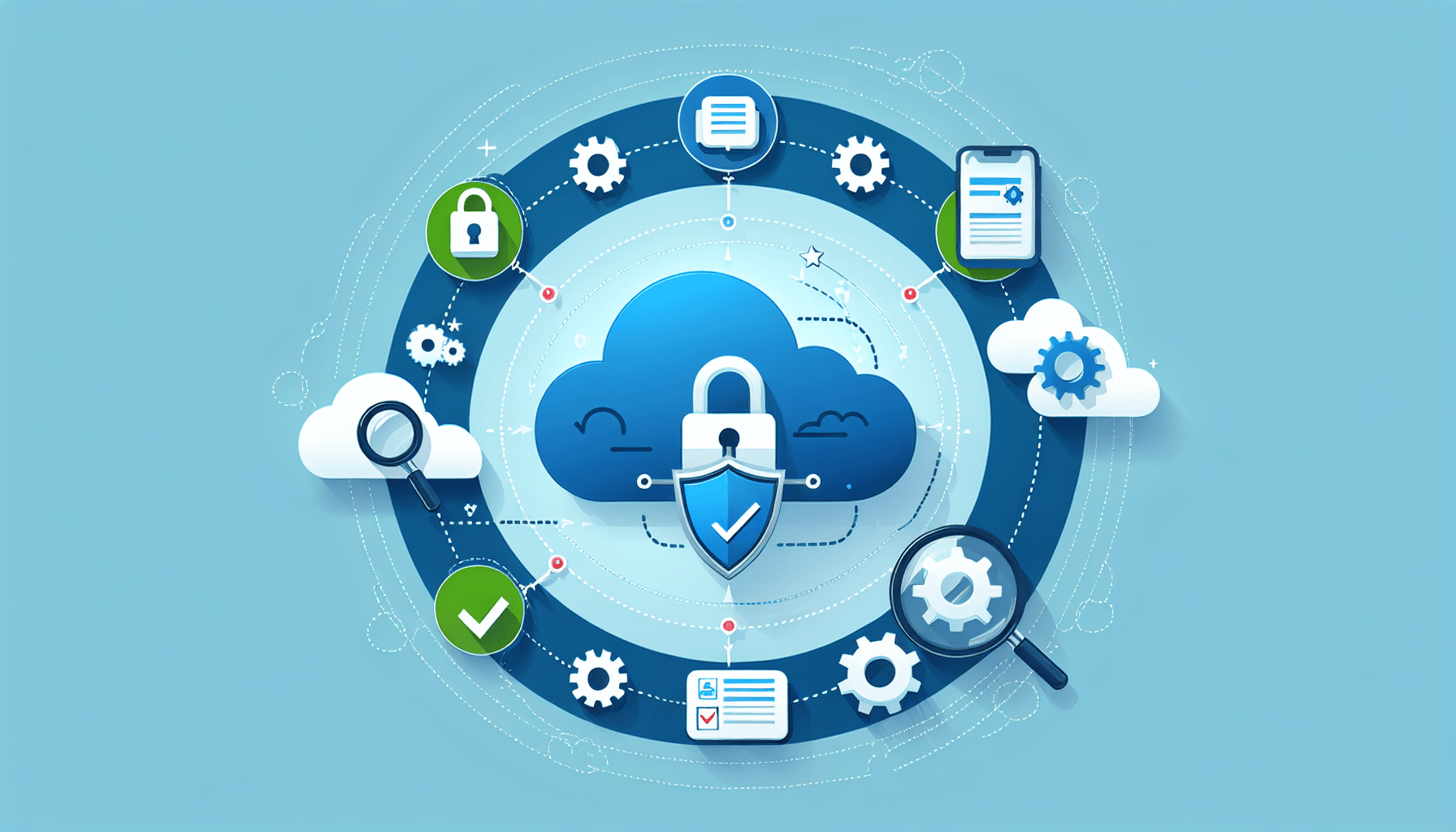In today’s rapidly evolving digital landscape, the use of cloud computing has become increasingly prevalent, with organizations across various industries relying on it to enhance their operational efficiency and scalability. However, the adoption of cloud technology also comes with inherent security risks. To mitigate these risks effectively, organizations must implement robust security measures. This article, titled “Cloud Security Assessment Frameworks: A Comparison Guide,” presents a concise overview of different cloud security assessment frameworks available in the market, enabling businesses to make informed decisions about selecting the most suitable framework for their specific needs.

Overview of Cloud Security Assessment Frameworks
Cloud Security Assessment Frameworks are tools that help organizations assess and evaluate the security of their cloud environment. These frameworks provide a set of guidelines and best practices for evaluating the security controls and processes implemented by cloud service providers. By using these frameworks, organizations can ensure that their cloud providers have implemented adequate security measures to protect their data and systems.
What are Cloud Security Assessment Frameworks?
Cloud Security Assessment Frameworks are a set of guidelines and standards that define the requirements for assessing and evaluating the security of cloud service providers. These frameworks provide organizations with a structured approach to assess the security of potential cloud service providers and choose the one that meets their security needs. They typically consist of a set of control objectives, controls, and assessment criteria that organizations can use to evaluate the security posture of cloud providers.
Why are Cloud Security Assessment Frameworks important?
Cloud Security Assessment Frameworks are important for several reasons. Firstly, they provide organizations with a standardized approach to assess the security of cloud service providers. This helps organizations compare different providers and choose the one that meets their security requirements. Secondly, these frameworks help organizations identify potential security risks and vulnerabilities in the cloud environment. By following the guidelines provided by these frameworks, organizations can implement and maintain a robust security posture in the cloud. Lastly, these frameworks help organizations ensure compliance with regulatory requirements and industry best practices.
Common Cloud Security Assessment Frameworks
There are several cloud security assessment frameworks available in the market. Let’s take a closer look at some of the most commonly used ones:
ISO 27001
ISO 27001 is a widely recognized international standard for information security management systems. It provides a systematic approach to managing sensitive company information and ensuring its security. The standard sets out the criteria for establishing, implementing, operating, monitoring, reviewing, maintaining, and improving an information security management system.
SOC 2
SOC 2, developed by the American Institute of Certified Public Accountants (AICPA), is a framework for assessing the security, availability, processing integrity, confidentiality, and privacy of cloud service providers. SOC 2 reports provide valuable information about the service organization’s control environment and can help organizations evaluate the effectiveness of the provider’s security controls.
NIST Cybersecurity Framework
The NIST Cybersecurity Framework is a set of voluntary guidelines and best practices for managing and reducing cybersecurity risks. It provides organizations with a framework to assess and improve their ability to prevent, detect, and respond to cyber threats. The framework consists of five core functions: Identify, Protect, Detect, Respond, and Recover.
Cloud Security Alliance (CSA) STAR
CSA STAR is a program operated by the Cloud Security Alliance that provides a framework for cloud service providers to assess and document their security controls. The program offers a publicly accessible registry where cloud providers can display their security assessment results, allowing organizations to make informed decisions about the security of their cloud providers.
PCI DSS
The Payment Card Industry Data Security Standard (PCI DSS) is a set of security standards designed to ensure the protection of cardholder data. It applies to any organization that stores, processes, or transmits cardholder data. Compliance with PCI DSS is mandatory for all organizations that accept payment cards.

Comparison Criteria
When comparing different cloud security assessment frameworks, organizations should consider several criteria. These criteria can help organizations assess the suitability of a framework for their specific needs. Let’s take a look at some of the most important comparison criteria:
Scope and Coverage
The scope and coverage of a framework refer to the areas of security that it addresses. Organizations should consider whether the framework covers all the relevant security domains and control objectives specific to their industry or regulatory requirements.
Risk Assessment
The framework’s approach to risk assessment is crucial in evaluating the effectiveness of its control objectives. Organizations should assess whether the framework provides a systematic and comprehensive approach to risk assessment that aligns with their risk management processes.
Control Framework
The control framework provided by the assessment framework determines the specific security controls and best practices that organizations should implement. Organizations should analyze whether the control framework is comprehensive, up-to-date, and aligned with industry standards and best practices.
Certification Process
The certification process defines the steps and requirements for achieving certification against the framework. Organizations should evaluate the certification process to ensure that it is achievable, cost-effective, and aligned with their business objectives.
Vendor Dependence
Organizations should consider the level of vendor dependence associated with a specific framework. Some frameworks require organizations to rely heavily on their cloud providers for security controls, while others provide more flexibility and allow organizations to implement additional controls independently.
Cost
The cost associated with implementing and maintaining the framework is an important consideration for organizations. This includes the cost of conducting assessments, meeting control objectives, and achieving and maintaining certification.
By carefully evaluating each of these criteria, organizations can choose the most appropriate cloud security assessment framework that aligns with their security requirements and business objectives.
ISO 27001
Overview of ISO 27001
ISO 27001 is an internationally recognized standard for information security management systems (ISMS). It provides a systematic approach to managing sensitive company information and ensuring its security. The standard covers various aspects of information security, including risk assessment, risk treatment, asset management, access control, physical security, incident management, and compliance with legal and regulatory requirements.
Strengths of ISO 27001
ISO 27001 has several strengths that make it a popular choice for organizations assessing the security of cloud service providers. Firstly, it provides a comprehensive framework for establishing, implementing, maintaining, and continually improving an ISMS. It offers a holistic approach to information security management and covers all key aspects of security.
Secondly, ISO 27001 is an internationally recognized standard, which means that organizations certified against ISO 27001 can demonstrate their commitment to information security to their customers, partners, and regulators. The standard provides a level of assurance that the organization has implemented adequate security controls and processes.
Lastly, ISO 27001 emphasizes the importance of risk assessment and risk treatment. It requires organizations to identify and assess the risks to their information assets and implement appropriate controls to mitigate those risks. This risk-based approach helps organizations prioritize their security efforts and allocate their resources effectively.
Weaknesses of ISO 27001
Despite its strengths, ISO 27001 has some limitations that organizations should consider when assessing the security of cloud service providers. Firstly, ISO 27001 is a generic standard that can be applied to any organization, regardless of its size, industry, or specific security requirements. This means that organizations may need to adapt and supplement the standard with additional controls and processes to address their specific needs.
Secondly, ISO 27001 does not provide detailed guidance on how to implement specific security controls. It outlines the requirements for an effective ISMS but does not provide a prescriptive set of controls that organizations should implement. While this provides flexibility, it can also result in organizations having to invest additional time and resources to design and implement their controls.
Lastly, ISO 27001 certification can be a lengthy and resource-intensive process. Organizations need to demonstrate compliance with all the requirements of the standard and undergo regular audits to maintain certification. This can be a significant investment in terms of time, effort, and cost.
Despite these limitations, ISO 27001 remains a widely recognized and respected framework for assessing the security of cloud service providers. Its comprehensive approach to information security management and emphasis on risk assessment and treatment make it a valuable tool for organizations.
SOC 2
Overview of SOC 2
SOC 2 (Service Organization Control 2) is a framework developed by the American Institute of Certified Public Accountants (AICPA). It provides a set of criteria for evaluating the security, availability, processing integrity, confidentiality, and privacy of cloud service providers. SOC 2 reports provide valuable information about the service organization’s control environment, allowing organizations to assess the effectiveness of the provider’s security controls.
Strengths of SOC 2
SOC 2 has several strengths that make it a popular choice for organizations evaluating the security of cloud service providers. Firstly, it provides a comprehensive framework for assessing the security, availability, processing integrity, confidentiality, and privacy of cloud services. By evaluating these five trust principles, organizations can gain a holistic view of the provider’s security posture.
Secondly, SOC 2 reports provide valuable information about the service organization’s control environment. These reports are conducted by independent auditors and provide an objective assessment of the provider’s controls. Organizations can use these reports to gain assurance that the provider has implemented adequate security controls and processes.
Lastly, SOC 2 reports are widely recognized and accepted by regulators, customers, and partners. The AICPA has established a rigorous process for conducting SOC 2 audits, ensuring that the reports are credible and reliable. Organizations can use these reports to demonstrate to their stakeholders that they have assessed the security of their cloud service providers in a thorough and independent manner.
Weaknesses of SOC 2
Despite its strengths, SOC 2 has some limitations that organizations should be aware of when evaluating the security of cloud service providers. Firstly, SOC 2 audits are conducted based on the specific control objectives and criteria defined by the organization and the auditor. This means that there may be variations in the scope and focus of the audits conducted by different auditors. Organizations should carefully review the scope and criteria used in the SOC 2 report to ensure that they align with their specific security requirements.
Secondly, SOC 2 reports are primarily focused on the control environment of the service organization. While this provides valuable information about the security controls implemented by the provider, it does not provide a comprehensive view of all the potential risks and vulnerabilities in the cloud environment. Organizations should supplement the SOC 2 report with their own risk assessments and evaluations.
Lastly, SOC 2 reports are conducted on an annual basis. This means that the reports may not reflect the most current security posture of the provider. Organizations should consider ongoing monitoring and assessments to ensure that the provider maintains a robust security posture.
Despite these limitations, SOC 2 remains a widely recognized and respected framework for evaluating the security of cloud service providers. Its comprehensive approach to assessing the security, availability, processing integrity, confidentiality, and privacy of cloud services makes it a valuable tool for organizations.
NIST Cybersecurity Framework
Overview of NIST Cybersecurity Framework
The NIST Cybersecurity Framework is a set of voluntary guidelines and best practices for managing and reducing cybersecurity risks. It provides organizations with a framework to assess and improve their ability to prevent, detect, and respond to cyber threats. The framework consists of five core functions: Identify, Protect, Detect, Respond, and Recover.
Strengths of NIST Cybersecurity Framework
The NIST Cybersecurity Framework has several strengths that make it a popular choice for organizations evaluating the security of cloud service providers. Firstly, it provides a flexible and adaptable framework that can be customized to the specific needs of an organization. The framework does not prescribe specific security controls but instead focuses on guiding organizations to develop and implement an effective cybersecurity program.
Secondly, the NIST Cybersecurity Framework has been widely adopted by both public and private sector organizations. This means that organizations evaluating the security of cloud service providers can use the framework to align their assessment with industry best practices and standards.
Lastly, the NIST Cybersecurity Framework is continually updated and improved based on industry feedback and emerging threats. This ensures that the framework remains relevant and effective in addressing the constantly evolving cybersecurity landscape.
Weaknesses of NIST Cybersecurity Framework
Despite its strengths, the NIST Cybersecurity Framework has some limitations that organizations should consider when evaluating the security of cloud service providers. Firstly, the framework is voluntary and not mandatory. While organizations can choose to adopt and implement the framework, there are no formal requirements or certifications associated with it. This means that organizations need to rely on self-assessment and self-reporting to evaluate the security posture of cloud service providers using the framework.
Secondly, the framework does not provide specific guidance on how to implement individual security controls. It provides high-level guidance and best practices but does not provide detailed instructions on how to design, implement, and maintain specific security controls. Organizations need to supplement the framework with additional guidance and expertise to ensure the effective implementation of security controls.
Lastly, the NIST Cybersecurity Framework is primarily focused on managing cybersecurity risks within an organization. While it provides guidance on assessing and improving the security of cloud service providers, it may not cover all the specific risks and challenges associated with the cloud environment. Organizations should conduct a careful assessment of the framework’s applicability to their specific cloud security needs.
Despite these limitations, the NIST Cybersecurity Framework remains a valuable tool for organizations evaluating the security of cloud service providers. Its flexibility, alignment with industry best practices, and ongoing updates make it a versatile and relevant framework for managing cybersecurity risks.
Cloud Security Alliance (CSA) STAR
Overview of CSA STAR
The Cloud Security Alliance (CSA) STAR program is a widely recognized cloud security assessment framework. It provides a set of criteria for cloud service providers to assess and document their security controls, and offers a publicly accessible registry where providers can display their assessment results. The CSA STAR program aims to increase transparency and give organizations a way to assess the security posture of their cloud service providers.
Strengths of CSA STAR
The CSA STAR program has several strengths that make it a popular choice for organizations evaluating the security of cloud service providers. Firstly, it provides a standardized and transparent approach to assessing the security of cloud services. By requiring providers to publicly disclose their assessment results, organizations can gain insights into the security controls implemented by the provider and make informed decisions about their suitability.
Secondly, the CSA STAR program covers a wide range of security domains, including data protection, identity and access management, vulnerability management, and incident response. This comprehensive coverage allows organizations to evaluate the provider’s security posture across multiple dimensions.
Lastly, the CSA STAR program offers different levels of certification, allowing providers to demonstrate their commitment to security at different levels. Organizations can choose to work with providers that have achieved higher levels of certification, providing a higher level of assurance in the security controls implemented by the provider.
Weaknesses of CSA STAR
Despite its strengths, the CSA STAR program has some limitations that organizations should consider when evaluating the security of cloud service providers. Firstly, the program relies on self-assessment by the cloud service providers. While the CSA provides guidance and criteria for the assessment, it does not conduct independent audits or certifications. This means that organizations need to carefully review and validate the assessment results disclosed by the provider.
Secondly, the CSA STAR program does not provide detailed guidance on how to implement specific security controls. The program focuses on assessing the existence and effectiveness of controls but does not prescribe specific controls and processes that providers should implement. This means that organizations may need to supplement the CSA STAR assessment with additional evaluations and assessments to ensure the completeness and adequacy of security controls.
Lastly, the CSA STAR program does not provide a standardized certification process. While providers can display their assessment results in the publicly accessible registry, the results may be based on different criteria and assessment methodologies. This makes it challenging for organizations to compare and evaluate providers based on their assessment results.
Despite these limitations, the CSA STAR program remains a valuable tool for organizations evaluating the security of cloud service providers. Its standardized approach, comprehensive coverage, and transparency make it an effective framework for assessing the security posture of cloud services.
PCI DSS
Overview of PCI DSS
The Payment Card Industry Data Security Standard (PCI DSS) is a set of security standards designed to ensure the protection of cardholder data. It applies to any organization that stores, processes, or transmits cardholder data. Compliance with PCI DSS is mandatory for all organizations that accept payment cards.
Strengths of PCI DSS
PCI DSS has several strengths that make it a popular choice for organizations assessing the security of cloud service providers. Firstly, it provides a clear and prescriptive set of security requirements that organizations must comply with to protect cardholder data. The standard covers various aspects of security, including network security, access control, encryption, vulnerability management, and incident response.
Secondly, PCI DSS is widely recognized and accepted by the payment card industry. Compliance with PCI DSS is mandatory for organizations that accept payment cards, and non-compliance can result in severe penalties, including fines and loss of card payment privileges. By choosing a PCI DSS compliant cloud service provider, organizations can ensure that they are working with a provider that follows industry best practices and meets the stringent security requirements of the payment card industry.
Lastly, PCI DSS certification involves independent audits by Qualified Security Assessors (QSAs) who are approved by the Payment Card Industry Security Standards Council (PCI SSC). These audits provide an objective assessment of the provider’s security controls and processes. By selecting a PCI DSS certified cloud service provider, organizations can gain assurance that the provider has implemented adequate security measures to protect cardholder data.
Weaknesses of PCI DSS
Despite its strengths, PCI DSS has some limitations that organizations should consider when assessing the security of cloud service providers. Firstly, PCI DSS is specifically designed to protect cardholder data and may not cover all the security requirements of an organization. Organizations should conduct a careful evaluation of the provider’s controls and processes to ensure that they satisfy their broader security needs.
Secondly, achieving and maintaining PCI DSS compliance can be a resource-intensive process. Organizations need to implement and maintain a wide range of security controls, undergo regular audits, and address any identified vulnerabilities or non-compliance issues. This can be a significant investment in terms of time, effort, and cost.
Lastly, PCI DSS compliance is a point-in-time assessment. It provides assurance that the provider has met the security requirements at the time of the assessment, but it does not guarantee the ongoing security of the provider. Organizations should consider ongoing monitoring and assessments to ensure that the provider maintains a strong security posture.
Despite these limitations, PCI DSS remains a widely recognized and respected framework for assessing the security of cloud service providers, especially when it comes to protecting cardholder data. Its clear and prescriptive requirements, industry acceptance, and third-party audits make it an effective tool for ensuring the security of payment card data.
Evaluation Process
Assessing the security of cloud service providers using a cloud security assessment framework involves a structured evaluation process. Let’s take a closer look at the steps involved in evaluating the security of a cloud provider:
Step 1: Identifying the Cloud Security Assessment Framework
The first step in the evaluation process is to identify the most suitable cloud security assessment framework for your organization’s needs. Consider factors such as specific security requirements, industry standards, and regulatory compliance as you select the appropriate framework.
Step 2: Understanding the Framework’s Criteria
Once you have identified the framework, familiarize yourself with its criteria and requirements. Understand the scope, objectives, and control framework provided by the framework. This will help you tailor your evaluation process and ensure that you meet all the necessary criteria.
Step 3: Assessing the Cloud Provider’s Compliance
Next, assess the cloud provider’s compliance with the framework’s criteria. Review the provider’s assessment reports, certifications, and other relevant documentation to ensure that the provider has implemented the necessary security controls and processes. Consider factors such as the provider’s control environment, risk assessment, vulnerability management, incident response, and compliance with relevant legal and regulatory requirements.
Step 4: Analyzing the Results
Analyze the results of your assessment and compare them to your organization’s security requirements and risk tolerance. Identify any gaps or deficiencies in the provider’s security controls and evaluate the impact of these gaps on your organization’s security posture. Consider factors such as the provider’s risk management processes, incident response capabilities, and ability to meet your specific security needs.
Step 5: Making an Informed Decision
Based on your analysis, make an informed decision about whether the cloud provider meets your organization’s security requirements. Consider factors such as the suitability of the provider’s security controls, the provider’s compliance with relevant industry standards and regulations, the level of vendor dependence, and the overall cost of the service. Make sure to document your evaluation process and the reasons behind your decision.
By following this evaluation process, you can ensure that you assess the security of cloud service providers in a systematic and comprehensive manner. This will help you make informed decisions about the suitability of cloud providers and ensure the security of your organization’s data and systems.
Conclusion
Cloud security assessment frameworks are valuable tools for organizations evaluating the security of cloud service providers. They provide a structured approach to assessing and evaluating the security controls and processes implemented by cloud providers. By using these frameworks, organizations can ensure that their cloud providers have implemented adequate security measures to protect their data and systems.
In this article, we explored several commonly used cloud security assessment frameworks, including ISO 27001, SOC 2, NIST Cybersecurity Framework, CSA STAR, and PCI DSS. We compared these frameworks based on criteria such as scope and coverage, risk assessment, control framework, certification process, vendor dependence, and cost. Each framework has its strengths and weaknesses, and organizations should carefully evaluate them to choose the one that best suits their security requirements and business objectives.
We also discussed the evaluation process for assessing the security of cloud service providers using these frameworks. This process involves identifying the framework, understanding its criteria, assessing the provider’s compliance, analyzing the results, and making an informed decision.
In conclusion, cloud security assessment frameworks provide organizations with the tools and guidance needed to make informed decisions about the security of their cloud service providers. By following a structured evaluation process and considering the specific needs of their organization, organizations can ensure that they choose the right cloud service provider and maintain a robust security posture in the cloud.



